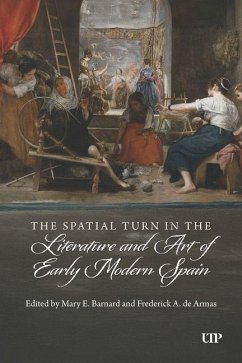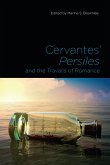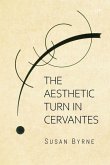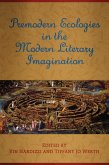Mary E Barnard, Frederick a de Armas
The Spatial Turn in the Literature and Art of Early Modern Spain
Versandkostenfrei innerhalb Deutschlands
79,99 €
inkl. MwSt.
Versandkostenfrei*
Erscheint vorauss. 20. Januar 2026
Melden Sie sich
hier
hier
für den Produktalarm an, um über die Verfügbarkeit des Produkts informiert zu werden.

40 °P sammeln
Mary E Barnard, Frederick a de Armas
The Spatial Turn in the Literature and Art of Early Modern Spain
- Gebundenes Buch
This book investigates new ways in which writers and artists of early modern Spain conceived of space through the lens of what recent studies have called the spatial turn and explores space as a cultural construct.
Andere Kunden interessierten sich auch für
![Cervantes' Persiles and the Travails of Romance Cervantes' Persiles and the Travails of Romance]() Marina S BrownleeCervantes' Persiles and the Travails of Romance78,99 €
Marina S BrownleeCervantes' Persiles and the Travails of Romance78,99 €![The English Reformation in the Spanish Imagination The English Reformation in the Spanish Imagination]() Deborah R FortezaThe English Reformation in the Spanish Imagination64,99 €
Deborah R FortezaThe English Reformation in the Spanish Imagination64,99 €![The Aesthetic Turn in Cervantes The Aesthetic Turn in Cervantes]() Susan ByrneThe Aesthetic Turn in Cervantes71,99 €
Susan ByrneThe Aesthetic Turn in Cervantes71,99 €![Iberian Chivalric Romance Iberian Chivalric Romance]() Leticia AlvarezrecioIberian Chivalric Romance82,99 €
Leticia AlvarezrecioIberian Chivalric Romance82,99 €![Quixotic Memories Quixotic Memories]() Julia DominguezQuixotic Memories73,99 €
Julia DominguezQuixotic Memories73,99 €![Premodern Ecologies in the Modern Literary Imagination Premodern Ecologies in the Modern Literary Imagination]() Vin NardizziPremodern Ecologies in the Modern Literary Imagination83,99 €
Vin NardizziPremodern Ecologies in the Modern Literary Imagination83,99 €![Teaching Early Modern English Literature from the Archives Teaching Early Modern English Literature from the Archives]() Teaching Early Modern English Literature from the Archives97,99 €
Teaching Early Modern English Literature from the Archives97,99 €-
-
-
This book investigates new ways in which writers and artists of early modern Spain conceived of space through the lens of what recent studies have called the spatial turn and explores space as a cultural construct.
Produktdetails
- Produktdetails
- Verlag: University of Toronto Press
- Seitenzahl: 272
- Erscheinungstermin: 20. Januar 2026
- Englisch
- Abmessung: 229mm x 152mm x 25mm
- ISBN-13: 9781487565336
- ISBN-10: 148756533X
- Artikelnr.: 73933402
- Herstellerkennzeichnung
- Libri GmbH
- Europaallee 1
- 36244 Bad Hersfeld
- gpsr@libri.de
- Verlag: University of Toronto Press
- Seitenzahl: 272
- Erscheinungstermin: 20. Januar 2026
- Englisch
- Abmessung: 229mm x 152mm x 25mm
- ISBN-13: 9781487565336
- ISBN-10: 148756533X
- Artikelnr.: 73933402
- Herstellerkennzeichnung
- Libri GmbH
- Europaallee 1
- 36244 Bad Hersfeld
- gpsr@libri.de
Mary E. Barnard is a professor of Spanish and comparative literature at the Pennsylvania State University. Frederick A. de Armas is Robert O. Anderson Distinguished Service Professor at the University of Chicago..
List of Illustrations
Acknowledgments
Introduction: The Spatial Scene
Part 1: Spaces of Voicing, Intellectual Inquiry, and the Sublime
1. Acoustic Spaces: Vocal Performance and Trauma in Sonnets
Fernando de Herrera and Mary E. Barnard
2. “Ward Off This Gloomy Darkness”: Spaces of Conflict and Sublimity in
Calderón’s La vida es sueño
Frederick A. de Armas
3. The Space of Memory: Three Sixteenth-Century Iberian Examples
Marina S. Brownlee
4. Geographic Games: Cosmic Mapping and Make-Believe in Jewish Thought,
Medieval Alexander Romances, and Cervantes’s Modern Fiction
Keith Budner
Part 2: Spaces for the Performance of Alternate Realities
5. Early Modern Geotagging in Cervantes’s El coloquio de los perros
Carolyn A. Nadeau
6. Eluding Surveillance and Repression in Early Modern Madrid:
Manufacturing Safety through Street Performances in Cervantes’s La
gitanilla
Matías A. Spector
7. Performance Space in Cervantes’s Pedro de Urdemalas
Edward H. Friedman
8. The Person of a King: Sovereignty, Performance, and Court Spaces in
Three Royal Imposter Plays
Christopher B. Weimer
Part 3: Sacred Spaces
9. Poeticizing Spaces in Seventeen-Century Religious Poetry
María Cristina Quintero
10. Mirrors, Self Portraits, and Visionary Exemplarity: An Analysis of the
Guadalupe Chapel, Royal Discalced Convent, Madrid.
Rosilie Hernández
11. The Spatial Display of Poetry in Recibimiento al obispo Pimentel (1629)
Victor Sierra Matute
12. Spaces of Death: The Virgin of the Arch and the Cult of the Dead in
María de Zayas’s La fuerza del Amor
Ryan D. Giles
Contributors
Acknowledgments
Introduction: The Spatial Scene
Part 1: Spaces of Voicing, Intellectual Inquiry, and the Sublime
1. Acoustic Spaces: Vocal Performance and Trauma in Sonnets
Fernando de Herrera and Mary E. Barnard
2. “Ward Off This Gloomy Darkness”: Spaces of Conflict and Sublimity in
Calderón’s La vida es sueño
Frederick A. de Armas
3. The Space of Memory: Three Sixteenth-Century Iberian Examples
Marina S. Brownlee
4. Geographic Games: Cosmic Mapping and Make-Believe in Jewish Thought,
Medieval Alexander Romances, and Cervantes’s Modern Fiction
Keith Budner
Part 2: Spaces for the Performance of Alternate Realities
5. Early Modern Geotagging in Cervantes’s El coloquio de los perros
Carolyn A. Nadeau
6. Eluding Surveillance and Repression in Early Modern Madrid:
Manufacturing Safety through Street Performances in Cervantes’s La
gitanilla
Matías A. Spector
7. Performance Space in Cervantes’s Pedro de Urdemalas
Edward H. Friedman
8. The Person of a King: Sovereignty, Performance, and Court Spaces in
Three Royal Imposter Plays
Christopher B. Weimer
Part 3: Sacred Spaces
9. Poeticizing Spaces in Seventeen-Century Religious Poetry
María Cristina Quintero
10. Mirrors, Self Portraits, and Visionary Exemplarity: An Analysis of the
Guadalupe Chapel, Royal Discalced Convent, Madrid.
Rosilie Hernández
11. The Spatial Display of Poetry in Recibimiento al obispo Pimentel (1629)
Victor Sierra Matute
12. Spaces of Death: The Virgin of the Arch and the Cult of the Dead in
María de Zayas’s La fuerza del Amor
Ryan D. Giles
Contributors
List of Illustrations
Acknowledgments
Introduction: The Spatial Scene
Part 1: Spaces of Voicing, Intellectual Inquiry, and the Sublime
1. Acoustic Spaces: Vocal Performance and Trauma in Sonnets
Fernando de Herrera and Mary E. Barnard
2. “Ward Off This Gloomy Darkness”: Spaces of Conflict and Sublimity in
Calderón’s La vida es sueño
Frederick A. de Armas
3. The Space of Memory: Three Sixteenth-Century Iberian Examples
Marina S. Brownlee
4. Geographic Games: Cosmic Mapping and Make-Believe in Jewish Thought,
Medieval Alexander Romances, and Cervantes’s Modern Fiction
Keith Budner
Part 2: Spaces for the Performance of Alternate Realities
5. Early Modern Geotagging in Cervantes’s El coloquio de los perros
Carolyn A. Nadeau
6. Eluding Surveillance and Repression in Early Modern Madrid:
Manufacturing Safety through Street Performances in Cervantes’s La
gitanilla
Matías A. Spector
7. Performance Space in Cervantes’s Pedro de Urdemalas
Edward H. Friedman
8. The Person of a King: Sovereignty, Performance, and Court Spaces in
Three Royal Imposter Plays
Christopher B. Weimer
Part 3: Sacred Spaces
9. Poeticizing Spaces in Seventeen-Century Religious Poetry
María Cristina Quintero
10. Mirrors, Self Portraits, and Visionary Exemplarity: An Analysis of the
Guadalupe Chapel, Royal Discalced Convent, Madrid.
Rosilie Hernández
11. The Spatial Display of Poetry in Recibimiento al obispo Pimentel (1629)
Victor Sierra Matute
12. Spaces of Death: The Virgin of the Arch and the Cult of the Dead in
María de Zayas’s La fuerza del Amor
Ryan D. Giles
Contributors
Acknowledgments
Introduction: The Spatial Scene
Part 1: Spaces of Voicing, Intellectual Inquiry, and the Sublime
1. Acoustic Spaces: Vocal Performance and Trauma in Sonnets
Fernando de Herrera and Mary E. Barnard
2. “Ward Off This Gloomy Darkness”: Spaces of Conflict and Sublimity in
Calderón’s La vida es sueño
Frederick A. de Armas
3. The Space of Memory: Three Sixteenth-Century Iberian Examples
Marina S. Brownlee
4. Geographic Games: Cosmic Mapping and Make-Believe in Jewish Thought,
Medieval Alexander Romances, and Cervantes’s Modern Fiction
Keith Budner
Part 2: Spaces for the Performance of Alternate Realities
5. Early Modern Geotagging in Cervantes’s El coloquio de los perros
Carolyn A. Nadeau
6. Eluding Surveillance and Repression in Early Modern Madrid:
Manufacturing Safety through Street Performances in Cervantes’s La
gitanilla
Matías A. Spector
7. Performance Space in Cervantes’s Pedro de Urdemalas
Edward H. Friedman
8. The Person of a King: Sovereignty, Performance, and Court Spaces in
Three Royal Imposter Plays
Christopher B. Weimer
Part 3: Sacred Spaces
9. Poeticizing Spaces in Seventeen-Century Religious Poetry
María Cristina Quintero
10. Mirrors, Self Portraits, and Visionary Exemplarity: An Analysis of the
Guadalupe Chapel, Royal Discalced Convent, Madrid.
Rosilie Hernández
11. The Spatial Display of Poetry in Recibimiento al obispo Pimentel (1629)
Victor Sierra Matute
12. Spaces of Death: The Virgin of the Arch and the Cult of the Dead in
María de Zayas’s La fuerza del Amor
Ryan D. Giles
Contributors







